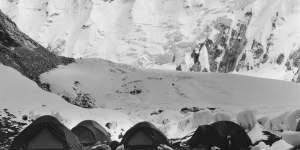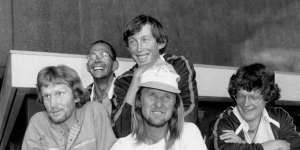Australians conquer Everest
From Simon Balderstone of ‘The Age’,at advance base camp,Rongbuk Glacier,Mount Everest.
Two Australian mountaineers have beaten intense cold and howling winds to reach the summit of Mount Everest.

Camp 1 on the edge of the Rongbuk Glacier Snowfield.Simon Balderstone
Tim Macartney-Snape and Greg Mortimer became the first Australians to stand on the 8848-metre summit at 5.30 p.m. on Wednesday (10 p.m. Melbourne time),just as the rays of the setting sun were striking the peak.
They beat unseasonably cold weather,avalanches and strong winds to become the first to conquer the mountain's difficult North Face without oxygen. Only 170 climbers have reached the summit of the world's tallest mountain and 60 have died in the attempt.
The climbers blazed a new route almost directly up the 3000-metre North Face. The route,when shown to a group of experienced American climbers on the mountain at the moment,was described by them as an"all-time classic",more impressive than that taken by the Japanese in 1980 — the only other group to succeed in climbing the North Face.
The Australians become the first of their country to the top,the first of any nation to scale the North Face in the post-monsoon period,and first to climb the face without oxygen.

Climbers in an ice cave at Rongbuk Glacier Mt Everest.The Age Archives
The Prime Minister,Mr Hawke,said last night that on behalf of all Australians he congratulated the expedition on its achievement.
"The dedication,courage and initiative of those involved has been justly rewarded.
“As in many other areas of endeavour,an Australian team has shown the capacity to meet the challenge. We are all proud of them."
The expedition,which included other climbers who turned back close to the summit,is a sharp contrast to most Everest expeditions. Sponsored by Channel Nine's'Wide World of Sport',the climb is an Alpine-style dash using lightweight equipment,no oxygen and a minimum of personnel.
The Australian climbers have spent the past month establishing supply dumps,rope-trails and camps on the mountain and began their serious attempt on the summit when the weather cleared on 22 September. After climbing from advance base camp (5500 metres) they began the final assault on the summit at 10 am on Wednesday in bright sunlight but intense cold.

The team returns to Australia (L to R) (front):Greg Mortimer,Geoff Bartram,Lincoln Hall. (Back):Andrew Henderson,and Tim Macartney-Snape.The Age Archives
A late monsoon season and temperatures as low as minus 30 degrees Celsius had prevented an earlier assault
Four climbers made the final attempt,Geoff Bartram,33,of Queanbeyan,having turned back on Monday at a height of 6950 metres complaining of headache. The four made their way up the Grand Couloir,a huge gully running upwards from a height of 7600 metres,over several snow slabs and rock bands,all at the slow speed dictated by lack of oxygen,to reach an altitude far higher than any Australian has stood before.
The final climb took its toll on all the climbers,Lincoln Hall,28,of Canberra,was the first to turn back just after 3 pm from 8300 metres.
Macartney-Snape,a 28-year-old skiing and mountaineering guide of Greta in Victoria,and Mortimer,31,a Sydney geologist,reached the peak at 8 pm after a 12-hour climb. Fifteen minutes later Andy Henderson,a 28-year-old Sydney electrical engineer,turned back only 50 metres below the summit.
The climbers were forced to retreat because of intense cold and strong winds,but are elated at the quick achievement in scaling the 3000 metre high North Face,which has only been climbed once before.
Returning to camp,they were forced to descend in the dark to avoid bivouacing on the face. All had returned safely to camp at 8100 metres by 3.30 am yesterday after 17 hours'climbing. All five climbers are well.
For Macartney-Snape and Mortimer,the success crowns a career marked by a determination to put Australians on the climbing map. Macartney-Snape,a co-director of Wilderness Expeditions,has scaled Dunagiri (1978),Kulu Himal (1979),Ama Dablam (1981),Mount Anyemagen (1981),Trisol (1982) and Annapurna 11 (1983). Mortimer,who worked as a geologist in mountains in New Zealand and Antarctica,has climbed in the Andes,Africa and the Himalayas and made the first traverse of Ball's Pyramid,a massive rock spire in the Pacific Ocean.
Although many have climbed Everest since Sir Edmund Hillary and Sherpa Tensing showed the way in 1953,the Australian climb is a genuine first ascent,and a remarkable achievement for such a small group without oxygen. The five climbers had only four film crew,two Nepalis who acted as cooks,and a journalist — myself — to support them.
The achievement is greater in that they had an unusually heavy and late monsoon to contend with which left the mountain unexpectedly plastered with snow. The destruction of Camp 2 by an avalanche was a serious blow overcome early in the expedition. Equipment was buried more than 10 metres deep in snow and was irretrievably lost.